The whole truth about the mobile amplifier "ORANGE-900 Plus"
Creating this blog, Saratov Electromechanical Plant REMO set itself the task of publishing reviews and results of testing its own production, which would contribute to a deeper understanding of our products and developments, as well as give answers to consumer questions that are not available in ordinary descriptions and publications. Also, we set the task to enter into a dialogue with the consumer and experts in the field of electronics, radio engineering, in order to improve the level and consumer qualities of the products produced. At the same time, we begin our first publication with an unscheduled material, which we were inspired by the text on this resource, published a few days earlier.
At the end of April, a review of the Orange-900 Plus mobile communication amplifier of the Saratov REMO plant products was published on this site.

In the photo: packaging from the amplifier of mobile communication Orange-900 plus
')
Any feedback is useful for the manufacturer, first of all, because it is an indicator of consumer interest in the product. But in this case, we cannot but engage in dialogue with the author. The published material seemed to us very tendentious for a number of reasons, in general, affecting the business reputation of the enterprise. That is why we asked the lead development engineer of this product to comment on it in as much detail as possible.
Let's sort some assumptions of the author:
The first statement:
“The materials are quite cheap - an outdoor antenna made of aluminum with traces of dirt, scratches and even unshipped chips in the place of the holes ...”
Antenna material is selected the most modern and technological. Following the import substitution program, we basically do not purchase the import profile, and even more so finished products or semi-finished products, as some of our “partners” in the market do, and successfully use our, Russian AD-1N (or analogue D16T). We are developing our own Russian production, constantly raising its level and culture, and we are trying less to turn to foreign suppliers. In addition, this antenna, like the product itself, does not claim to the premium class, this product is for the mass consumer.
All possible consequences of material processing are usually hidden from the eyes by protective and decorative elements. If the author of the review has seen any comments that violate the user properties or the aesthetic appearance of the product, at least you need to point to them. Below is a high resolution photo of the antenna elements. And where is the "bad metal processing"? We do not see at close range ...
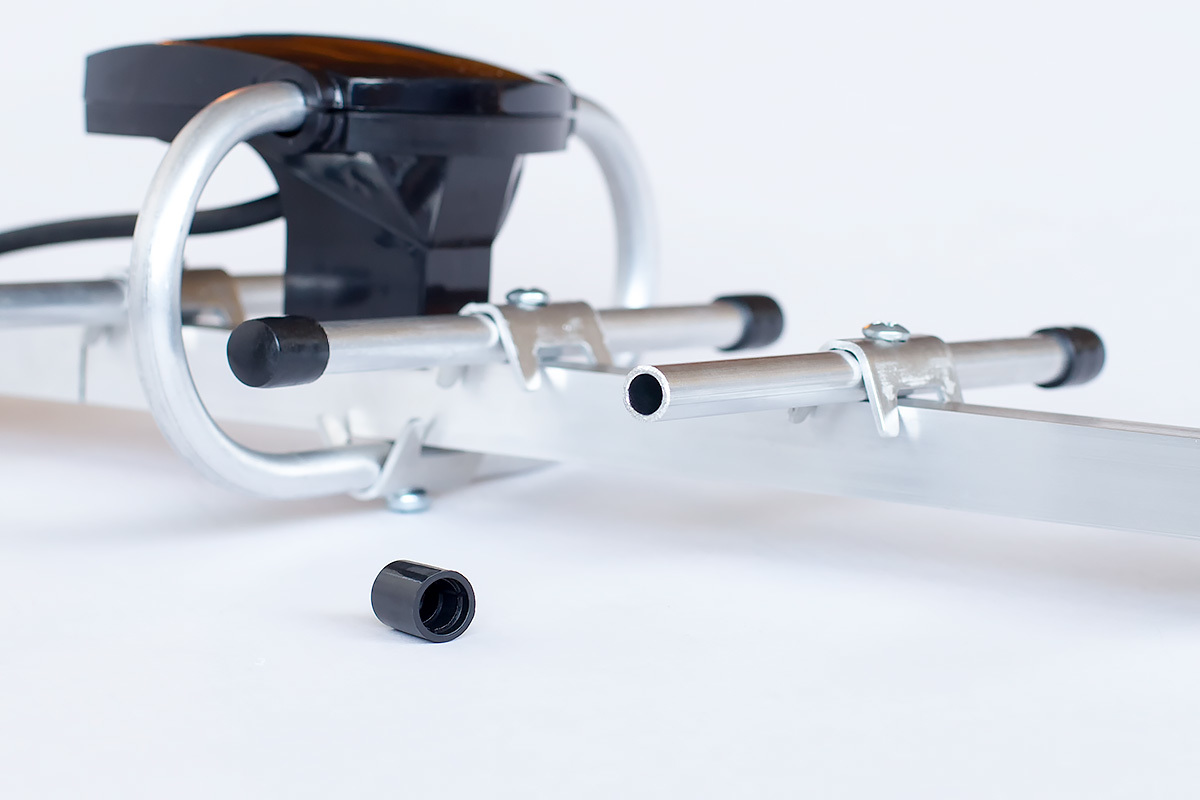
The photo shows an “uneven” edge (in fact, it is almost perfect), but even it is hidden under a special plastic cap.
The product used high-quality plastic type " ABS ". Mold, which pour plastic parts, has a smooth surface.
Thus, plastic parts coming out of this shape will be extremely smooth. The terms “thin and caustic” for a technical review of the expert level are not acceptable. But even if they are used, it is necessary to indicate a standard for comparison and specific locations of the hull, which in the author’s opinion are “caustic and thin”. This is not, however, the reader is already negatively tuned.
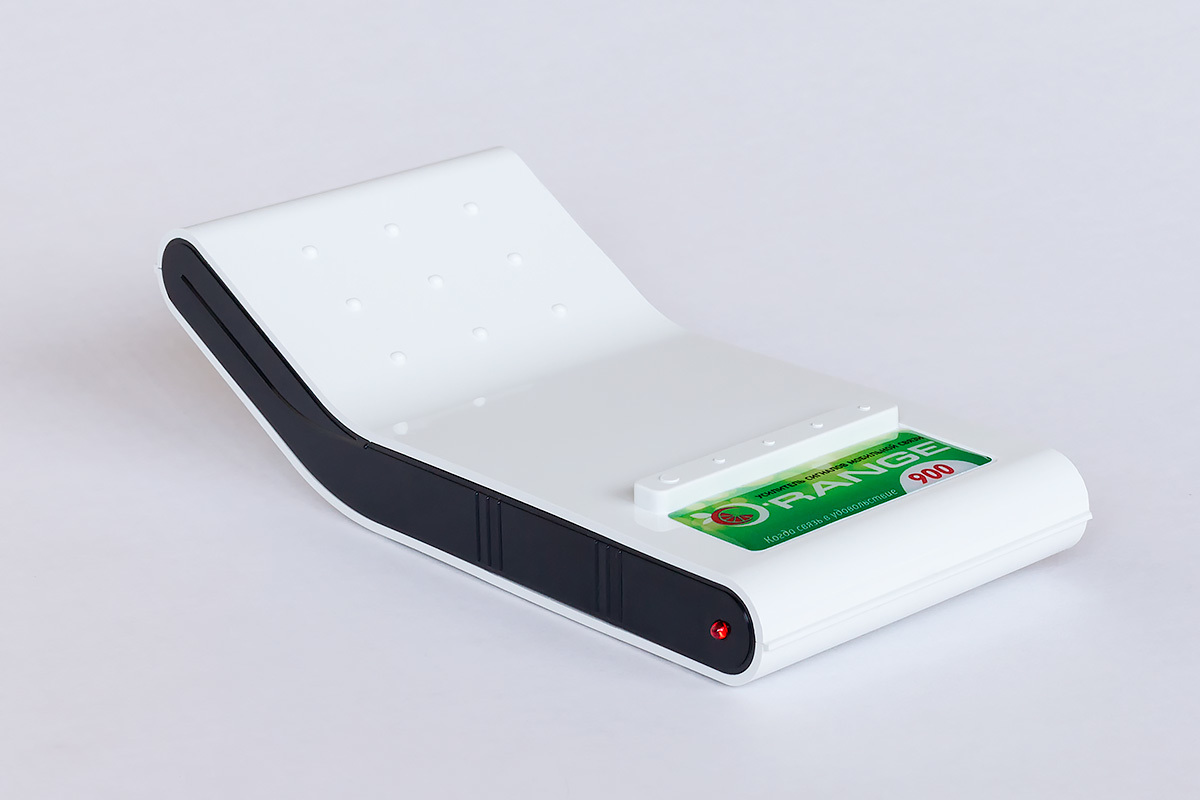
In the photo: Pay attention to the quality of plastic.
The following statement:
“Antenna of the“ wave channel ”type is rather short - only 4 elements. Antenna gain is not specified, but, judging by the size, about 4-5 dB "

In the photo: a wave channel antenna supplied with the Orange-900 plus.
First of all, it is necessary to say that the antenna is not 4, but five element. Yes, the antenna is a “wave channel” type design, however, the gain of such a 5-element antenna is 9-10 dBi (1 dBi is one decibel relative to an isotropic radiation source, if one of the “experts” is not aware). Secondly, only those “specialists” who know the antenna theory only by hearsay can indicate the antenna characteristic parameter in dB. The antenna gain is measured relative to an isotropic radiator, or dipole, respectively, the units of measure are specified in dBi or dBd.
To illustrate my words, not “by eye”, but using hardware and software, I attach the radiation pattern of this antenna in a vertical plane.
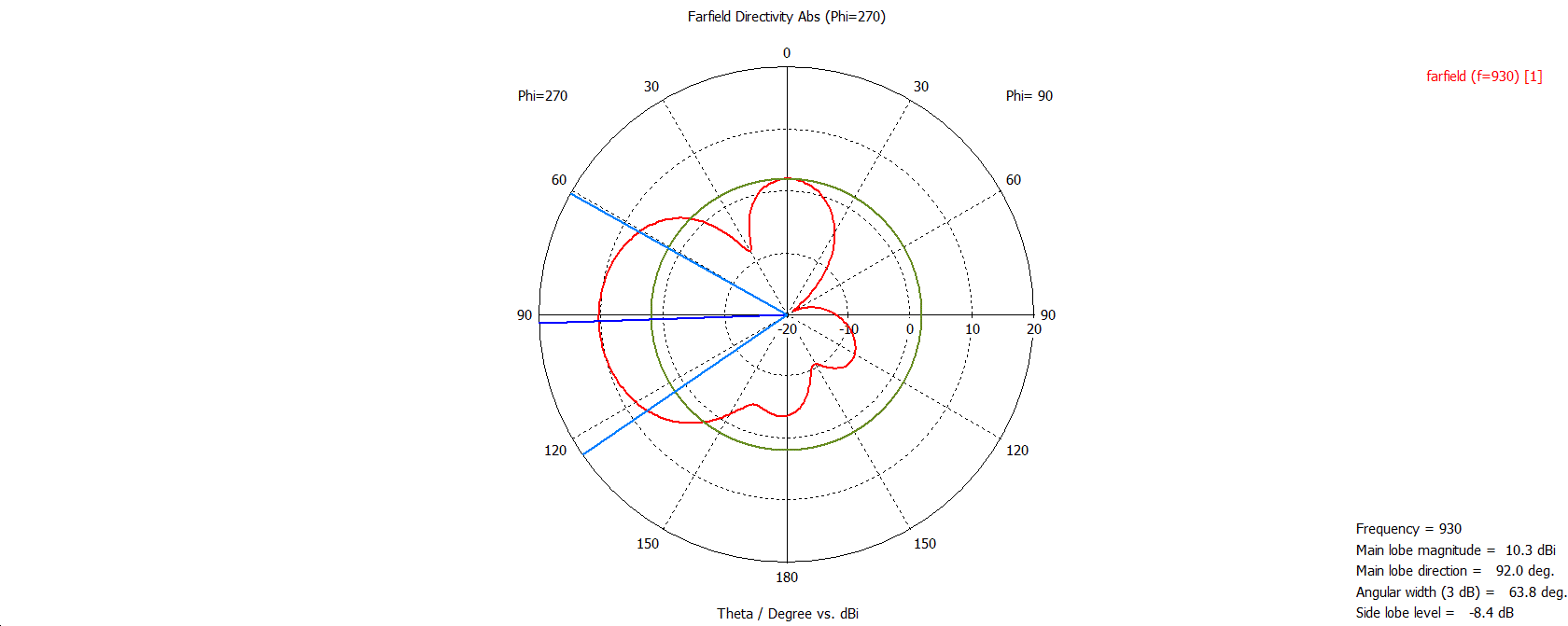
The antenna pattern at a frequency of 930 MHz, obtained during the 3D modeling of the antenna structure in one of the “ RF simulators”.
In the author's remark about the version of the ORANGE-900 Amplifier with a whip antenna, it is really close to the value of its nominal gain, even “by eye”. However, a kit with a whip antenna is positioned, first of all, as a room variant of antenna placement for urban conditions, when the signal is present "only at the window". There are many such situations and all mobile communication users are familiar with them.
Due to the circular pattern of the whip antenna, and due to the large number of base stations in urban areas, the user does not need to know the location of the operator’s BS, direct the antenna to the sector, just place it, for example, on a windowsill, at the maximum distance from the coverage unit. This is a simple solution for the average user, which does not require professional knowledge. And it quite has the right to life.
Go ahead:
“... that wave-channel antennas have an impedance of about 300 ohms and is there simply a matching device for matching with a 50-ohm cable?”
Wave channel antennas have different wave resistance, which depends on the antenna structure, type of active element, location of directors and many other nuances. These are common truths of antenna theory. "Expert" just had to know it!
During the simulation, by changing the shape and position of the vibrator, as well as adding directors to the near zone of the vibrator, resonance was obtained at frequencies close to 900 MHz, and the real part of the resistance at these frequencies of the calculated vibrator is located next to the 50 Ohms sought. Such a solution from the point of view of antenna construction is more competent, since it allows to avoid unnecessary losses in the matching transformer. So what the author gives a minus, of course, is a plus and a good decision.
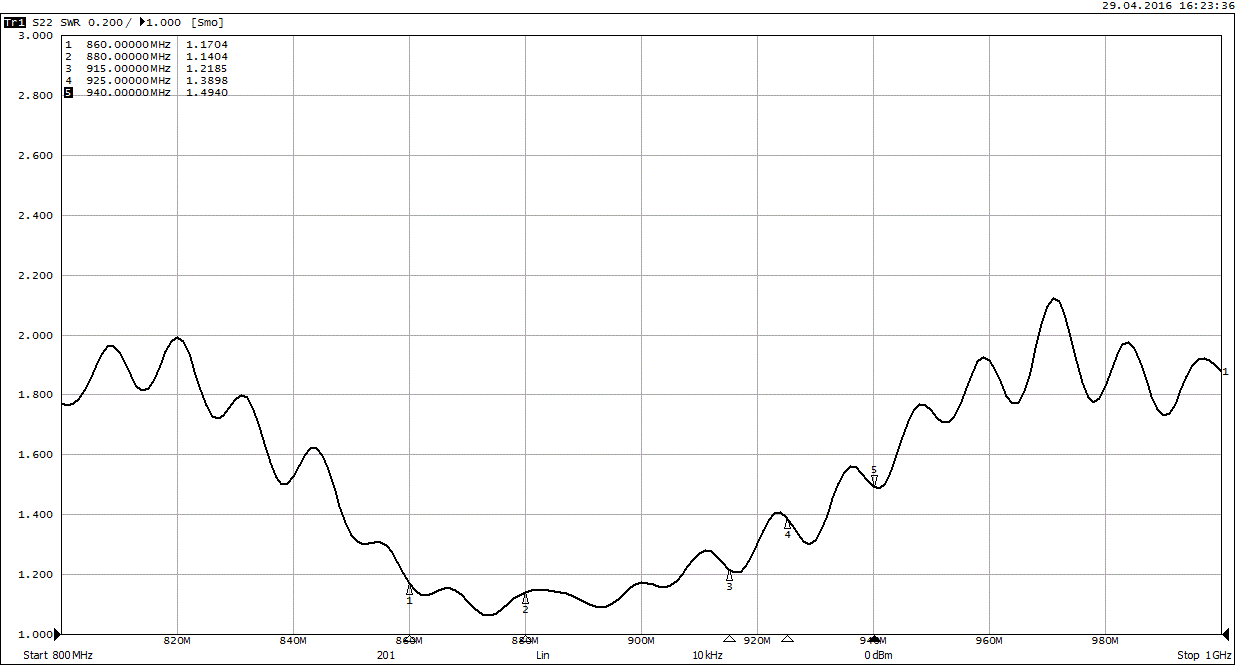
An SWR antenna with 6 meters of cable, bundled with Orange-900 Plus, measured on a PLANAR Obzor 804 \ 1 vector network analyzer
The following statement: “Losses on the absence of matching the antenna and cable will be very significant”
The main criterion for matching the antenna and the load is the antenna CWS , which in this case is within 1.5, which is considered normal.
According to our assumptions, at the disposal of the author of the review is a device “Advantest R3762”, which, in addition to removing the frequency response, allows you to measure VSWR ( VSWR ). Apparently, the resulting picture of the CWS violated the orderliness of the presentation, and he (the author) decided not to post a screen shot with the characteristic of the CWS, but simply assured the reader to believe “on the word” that the antenna does not have agreement and that is bad. We prefer to believe only the facts, so we lay out the characteristics of the antenna CWS.

In the photo: the spectrum analyzer AKS 16-01 used in the development of the product Orange-900.
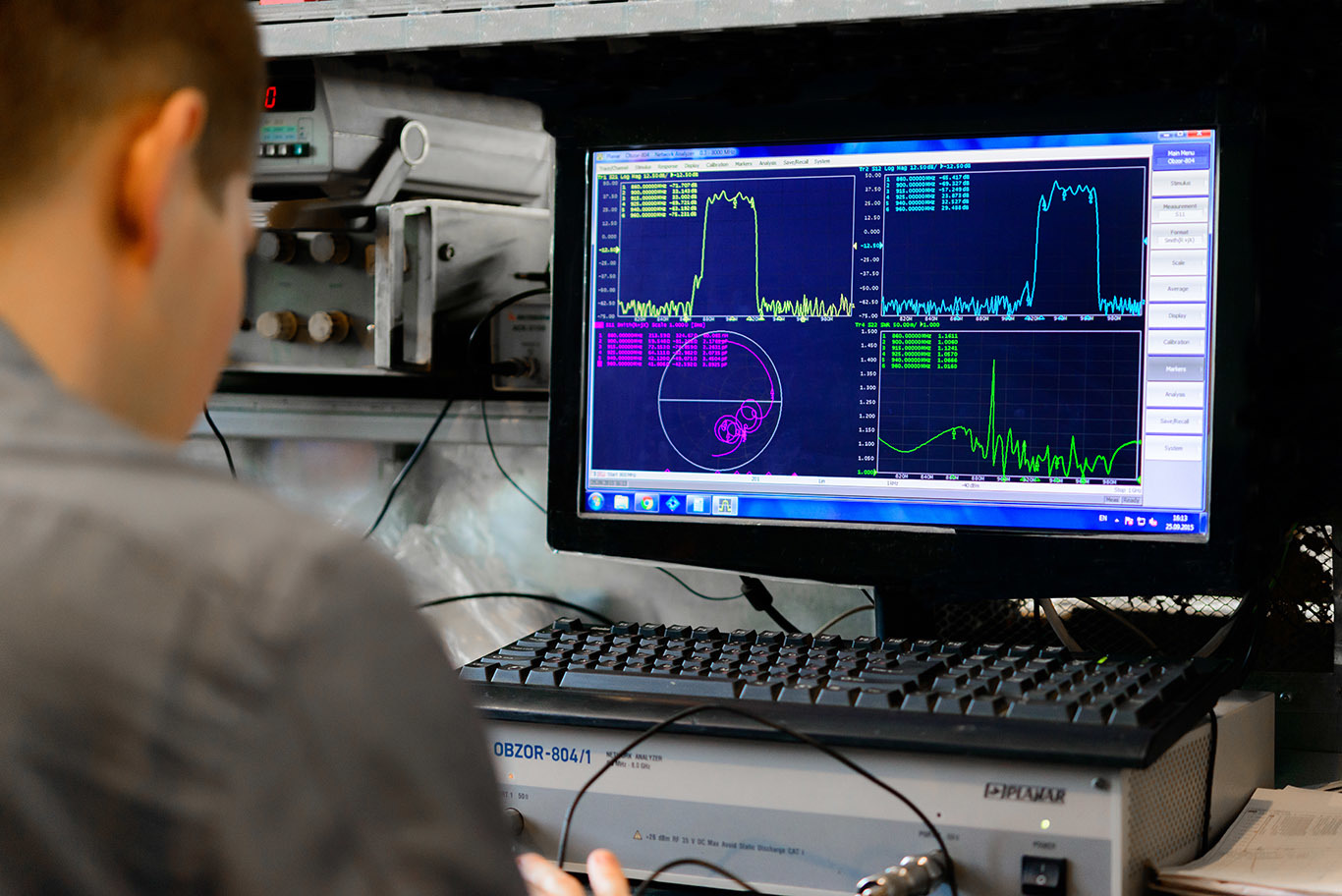
In the photo: the process of monitoring the parameters of the Orange-900 device.
Remark regarding the rejection of the use of a balancing device in the antenna (balun). We deliberately neglected the “balun”, since the antenna power does not depend on its presence. The absence of a balancing device introduces only deviations in the antenna pattern without changing the gain. And the form of DN itself is not important to us, it is important to reinforce in the main lobe and weaken “from behind” and “from the side”.
The following statement:
“We connect the repeater to the network analyzer and try to check if it really is.”
The author should support the attached images with a wiring diagram and a description of the methodology, since there are many nuances in the settings of any device of this type.
The product "Orange-900 Plus" is not a repeater , it is indicated in the documentation. Orange-900 Plus is a cellular signal enhancement system.
The following statement:
“I must admit that the overstatement of characteristics without any responsibility on the part of the manufacturer has become the norm recently. Unfortunately, the company REMO was no exception, saying about 50 dB, despite the fact that the gain does not reach and 40 dB "
Here we are talking about the total gain of the whole set together with the antenna. Summing up the gain of the module (40 dB) and the gain of the antenna (10 dBi) and we get the desired 50 dB. So it seems, and this statement is an empty sound.
Go ahead:
“At frequencies of 925-935 MHz, the non-uniformity of the frequency response reaches 15 dB! During operation, this can cause communication deterioration in the form of signal interruptions, disconnections and slower data transmission. "
As we know, each operator has its own band in each channel; therefore, when working with one of the operators, the system gain will be somewhat less than when working with other operators. Irregularity is present only in the Downlink channel (that is, the communication line from the operator to the user). In itself, a large gain through this channel is not necessary and, often, even harms, and more importantly, the gain in the Uplink channel (from subscriber to operator), in which just all the system gain is needed.
Of course, it was possible to work more on the characteristic, and to reduce this unevenness, but it’s wrong to speak about interruptions, decelerations and gaps during operation, relying on unevenness only in the Downlink channel. As long as there is a stable Uplink connection, the signal will also be stable.
Further: “Extremely“ budget ”cable RG-58U (with high losses in the working frequency band)”.
We have already said that our product does not pretend to a professional level. The product for the mass consumer can not be equipped with a super-cable. There is no big difference in losses on 6 meters of cable and it is definitely not worth being “driven” here. But this does not mean that the author is right about the loss of the cable used.
Not to be unsubstantiated:
The Orange-900 Plus uses a Landwell RG58AU cable (copper-plated braid, the center conductor is made of copper-plated steel). It is used by us in serial communication antennas at frequencies up to 2.6 GHz with a length of 6 meters.
Six meters of such a cable at a frequency of 900 MHz have a loss of 2.5 dB. Not so much, considering that the gain of the entire system is 50 dB.
Below is the loss characteristic at 6 meters of this cable, taken with the Obzor 804 \ 1 vector network analyzer. Measurements were carried out on RF connectors type SMA:

For comparison, the “5D-FB” cable (tinned copper braid, pure copper center conductor), belonging to the “extra” class cables, is 1.2 dB at the same length and frequency.
Total difference is 1.3 dB.
For the sake of this value, you definitely should not increase the cost of the product.
The following statement:
"The first thing that immediately draws attention is the absence of board shielding ... At frequencies close to 1 GHz, the waves are so short that even cracks and seams in the screen can play a role."
At such low frequencies as 1 GHz and at such levels of amplification, shielding is not needed. With proper wiring board, of course. Some manufacturers because of this forced to hide their mistakes behind additional screens. In modern cell phones, you rarely find screens, and in fact they operate at much higher frequencies. We reacted to the board topology thoughtfully and eliminated the need for a screen.
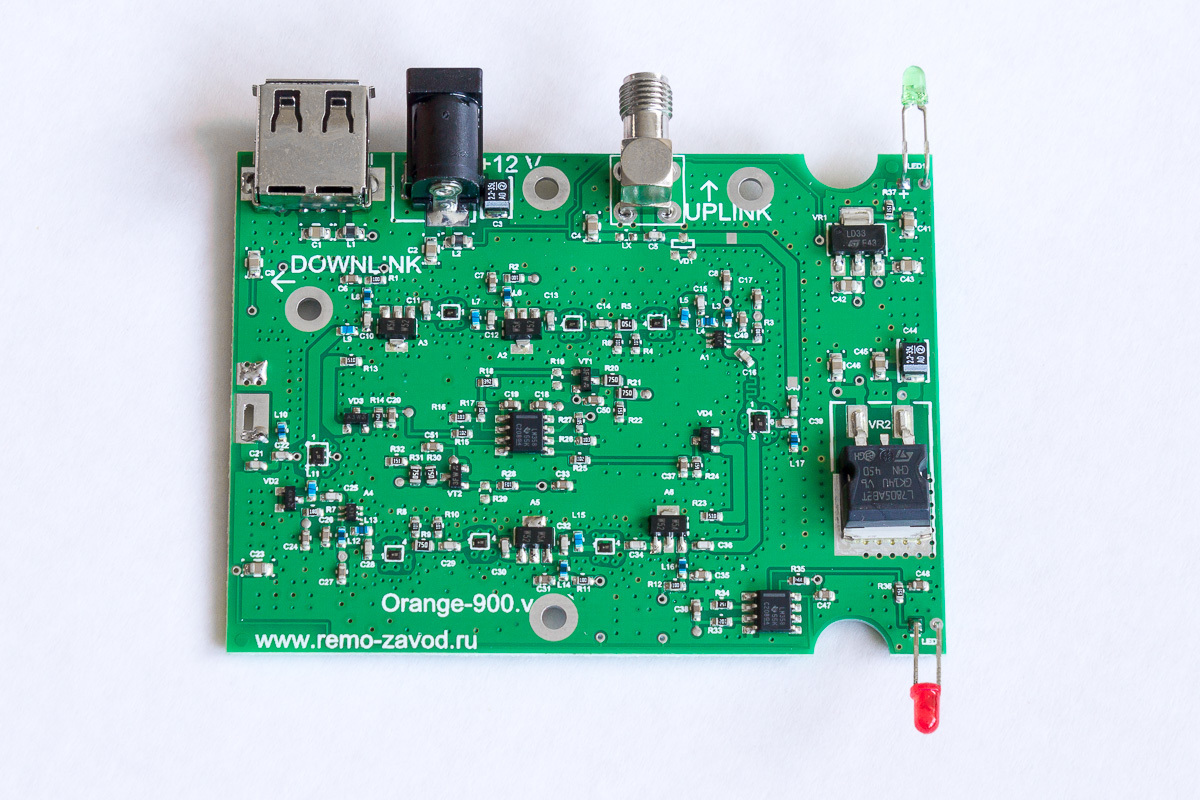
Photo: Orange-900 board
Further:
“Large solder balls, which can cause interelectrode short-circuits, also attract attention. In itself, their presence does not make the device inoperable, but eloquently speaks of the general culture of production and gives the impression of artisanal crafts rather than high-quality serial products "
After adjustment and verification, all the boards are cleaned with the use of ultrasound on special equipment and coated with varnish, which excludes all sorts of contrived interelectrode circuits. We carefully checked the serial cards again. Nothing even remotely resembling solder balls was detected. Which was to be expected.

Photo boards Orange-900 close-up. As you can see - no trace of solder!
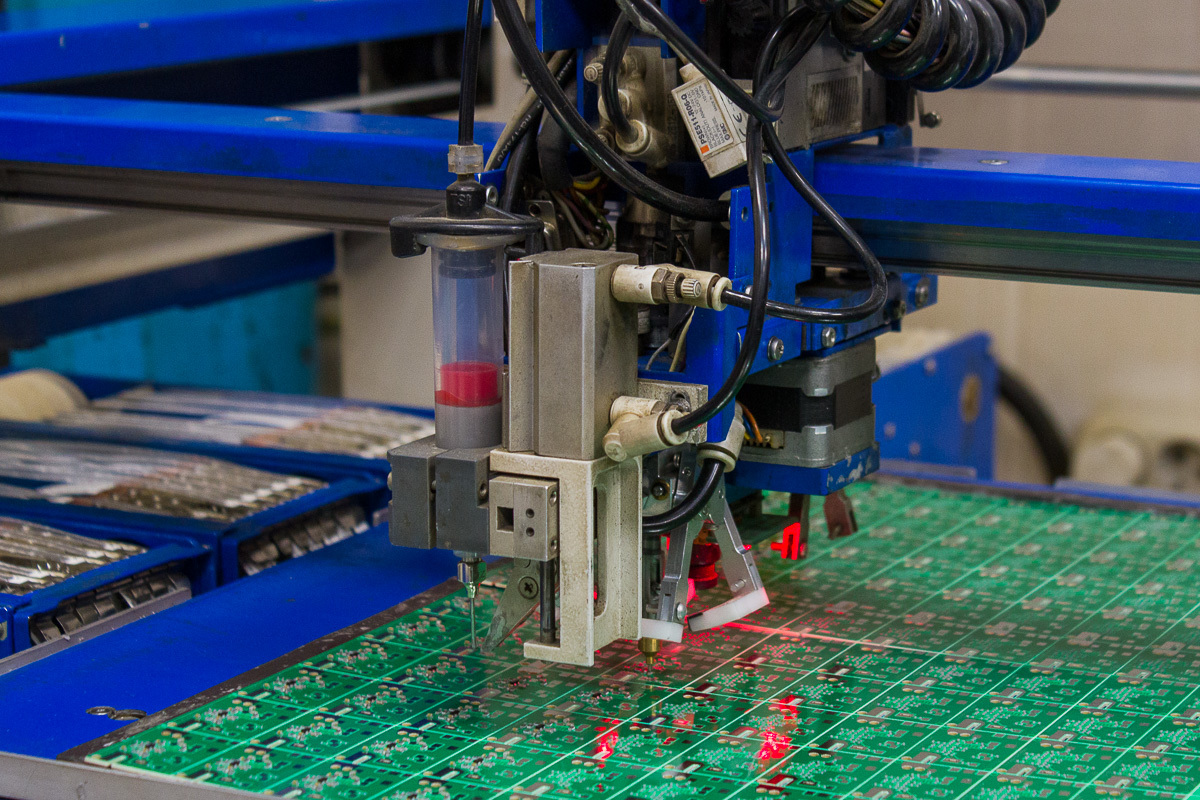
In the photo: the equipment on which the installation of chip elements in our production.
The following statement:
“The measurement was carried out in the conditions of the city. Operator - MTS. All data on the signal level is obtained using the standard monitor of the communication signal in the engineering menu of the phone (iPhone 5). "
Agree, when you make a professional review of the product, to measure the signal level only in the iPhone 5, at least, is unacceptable for the expert level.
In urban environments, many operators use a minimum of 900 MHz base stations or even do not have a 900 MHz band. In any case, the priority remains for the BS1800 , since It is they who work for the “capacity” of the network, and the BS900 - for coverage. The sectors of these BSs are placed at the highest positions and cover the town with a “cap”. Network capacity and missing coverage is created by the BS1800 sectors. When testing in the city, with high probability, the phone worked at completely different frequencies. For test measurements of a device similar to the “ORANGE-900 Plus”, it is necessary to use a suburban site excluding the 1800 MHz range, knowledge of the azimuth at the operator’s BS and the corresponding measuring equipment. Really the author did not guess about it?
Further:
“The system has an indication of emergency operation (green -“ normal ”, red -“ alarm ”), but the protection system itself (ie, automatic shutdown during emergency operation) is not in principle!”
This amplifier is implemented Automatic gain control (AGC or AGC). In the passport to the amplifier, it is described as “emergency power limiting mode”. This scheme will lower the gain level to a safe one in case of any “excitations” or other abnormal situations.
The description of the device contains the function of emergency power limitation, which starts when the “ALARM” signal is “triggered”, and is designed to reduce the gain in the event of self-excitation.
It is not necessary to completely turn off the device from the network in order to reduce the output power level. The device will do it for you, unlike other analogs, in which you need to manually turn off and re-turn on the power after each such event. This is especially inconvenient if the amplifier unit is placed, say, in the attic, and it is problematic to get to it every time. So the author "did not notice" the progressive function.
Excerpts from the author's text serve as a good example of the fact that everyone can review any product. Unfortunately, some users prefer to express their opinion, supporting it solely with emotions, forgetting facts and evidence. This post was written so that users of Orange-900 Plus or other similar devices understand that any opinion has a right to exist, but it cannot claim to be true, and it is enough to simply refute it, giving simple and understandable arguments.
We really want to believe that any author of a product review respects the developers and manufacturers of a particular product and adheres to the principle of “presumption of competence”. Otherwise, this is not a peer review, but a desire, for one reason or another, to “slam” the product. Let's respect the developer and manufacturer, they invest in their offspring all the knowledge, experience and even soul! However, thanks for your reviews and comments.
We thank you for your attention. See you in the new reviews!
At the end of April, a review of the Orange-900 Plus mobile communication amplifier of the Saratov REMO plant products was published on this site.

In the photo: packaging from the amplifier of mobile communication Orange-900 plus
')
Any feedback is useful for the manufacturer, first of all, because it is an indicator of consumer interest in the product. But in this case, we cannot but engage in dialogue with the author. The published material seemed to us very tendentious for a number of reasons, in general, affecting the business reputation of the enterprise. That is why we asked the lead development engineer of this product to comment on it in as much detail as possible.
Let's sort some assumptions of the author:
The first statement:
“The materials are quite cheap - an outdoor antenna made of aluminum with traces of dirt, scratches and even unshipped chips in the place of the holes ...”
Antenna material is selected the most modern and technological. Following the import substitution program, we basically do not purchase the import profile, and even more so finished products or semi-finished products, as some of our “partners” in the market do, and successfully use our, Russian AD-1N (or analogue D16T). We are developing our own Russian production, constantly raising its level and culture, and we are trying less to turn to foreign suppliers. In addition, this antenna, like the product itself, does not claim to the premium class, this product is for the mass consumer.
All possible consequences of material processing are usually hidden from the eyes by protective and decorative elements. If the author of the review has seen any comments that violate the user properties or the aesthetic appearance of the product, at least you need to point to them. Below is a high resolution photo of the antenna elements. And where is the "bad metal processing"? We do not see at close range ...

The photo shows an “uneven” edge (in fact, it is almost perfect), but even it is hidden under a special plastic cap.
The product used high-quality plastic type " ABS ". Mold, which pour plastic parts, has a smooth surface.
Thus, plastic parts coming out of this shape will be extremely smooth. The terms “thin and caustic” for a technical review of the expert level are not acceptable. But even if they are used, it is necessary to indicate a standard for comparison and specific locations of the hull, which in the author’s opinion are “caustic and thin”. This is not, however, the reader is already negatively tuned.

In the photo: Pay attention to the quality of plastic.
The following statement:
“Antenna of the“ wave channel ”type is rather short - only 4 elements. Antenna gain is not specified, but, judging by the size, about 4-5 dB "

In the photo: a wave channel antenna supplied with the Orange-900 plus.
First of all, it is necessary to say that the antenna is not 4, but five element. Yes, the antenna is a “wave channel” type design, however, the gain of such a 5-element antenna is 9-10 dBi (1 dBi is one decibel relative to an isotropic radiation source, if one of the “experts” is not aware). Secondly, only those “specialists” who know the antenna theory only by hearsay can indicate the antenna characteristic parameter in dB. The antenna gain is measured relative to an isotropic radiator, or dipole, respectively, the units of measure are specified in dBi or dBd.
To illustrate my words, not “by eye”, but using hardware and software, I attach the radiation pattern of this antenna in a vertical plane.

The antenna pattern at a frequency of 930 MHz, obtained during the 3D modeling of the antenna structure in one of the “ RF simulators”.
In the author's remark about the version of the ORANGE-900 Amplifier with a whip antenna, it is really close to the value of its nominal gain, even “by eye”. However, a kit with a whip antenna is positioned, first of all, as a room variant of antenna placement for urban conditions, when the signal is present "only at the window". There are many such situations and all mobile communication users are familiar with them.
Due to the circular pattern of the whip antenna, and due to the large number of base stations in urban areas, the user does not need to know the location of the operator’s BS, direct the antenna to the sector, just place it, for example, on a windowsill, at the maximum distance from the coverage unit. This is a simple solution for the average user, which does not require professional knowledge. And it quite has the right to life.
Go ahead:
“... that wave-channel antennas have an impedance of about 300 ohms and is there simply a matching device for matching with a 50-ohm cable?”
Wave channel antennas have different wave resistance, which depends on the antenna structure, type of active element, location of directors and many other nuances. These are common truths of antenna theory. "Expert" just had to know it!
During the simulation, by changing the shape and position of the vibrator, as well as adding directors to the near zone of the vibrator, resonance was obtained at frequencies close to 900 MHz, and the real part of the resistance at these frequencies of the calculated vibrator is located next to the 50 Ohms sought. Such a solution from the point of view of antenna construction is more competent, since it allows to avoid unnecessary losses in the matching transformer. So what the author gives a minus, of course, is a plus and a good decision.

An SWR antenna with 6 meters of cable, bundled with Orange-900 Plus, measured on a PLANAR Obzor 804 \ 1 vector network analyzer
The following statement: “Losses on the absence of matching the antenna and cable will be very significant”
The main criterion for matching the antenna and the load is the antenna CWS , which in this case is within 1.5, which is considered normal.
According to our assumptions, at the disposal of the author of the review is a device “Advantest R3762”, which, in addition to removing the frequency response, allows you to measure VSWR ( VSWR ). Apparently, the resulting picture of the CWS violated the orderliness of the presentation, and he (the author) decided not to post a screen shot with the characteristic of the CWS, but simply assured the reader to believe “on the word” that the antenna does not have agreement and that is bad. We prefer to believe only the facts, so we lay out the characteristics of the antenna CWS.

In the photo: the spectrum analyzer AKS 16-01 used in the development of the product Orange-900.

In the photo: the process of monitoring the parameters of the Orange-900 device.
Remark regarding the rejection of the use of a balancing device in the antenna (balun). We deliberately neglected the “balun”, since the antenna power does not depend on its presence. The absence of a balancing device introduces only deviations in the antenna pattern without changing the gain. And the form of DN itself is not important to us, it is important to reinforce in the main lobe and weaken “from behind” and “from the side”.
The following statement:
“We connect the repeater to the network analyzer and try to check if it really is.”
The author should support the attached images with a wiring diagram and a description of the methodology, since there are many nuances in the settings of any device of this type.
The product "Orange-900 Plus" is not a repeater , it is indicated in the documentation. Orange-900 Plus is a cellular signal enhancement system.
The following statement:
“I must admit that the overstatement of characteristics without any responsibility on the part of the manufacturer has become the norm recently. Unfortunately, the company REMO was no exception, saying about 50 dB, despite the fact that the gain does not reach and 40 dB "
Here we are talking about the total gain of the whole set together with the antenna. Summing up the gain of the module (40 dB) and the gain of the antenna (10 dBi) and we get the desired 50 dB. So it seems, and this statement is an empty sound.
Go ahead:
“At frequencies of 925-935 MHz, the non-uniformity of the frequency response reaches 15 dB! During operation, this can cause communication deterioration in the form of signal interruptions, disconnections and slower data transmission. "
As we know, each operator has its own band in each channel; therefore, when working with one of the operators, the system gain will be somewhat less than when working with other operators. Irregularity is present only in the Downlink channel (that is, the communication line from the operator to the user). In itself, a large gain through this channel is not necessary and, often, even harms, and more importantly, the gain in the Uplink channel (from subscriber to operator), in which just all the system gain is needed.
Of course, it was possible to work more on the characteristic, and to reduce this unevenness, but it’s wrong to speak about interruptions, decelerations and gaps during operation, relying on unevenness only in the Downlink channel. As long as there is a stable Uplink connection, the signal will also be stable.
Further: “Extremely“ budget ”cable RG-58U (with high losses in the working frequency band)”.
We have already said that our product does not pretend to a professional level. The product for the mass consumer can not be equipped with a super-cable. There is no big difference in losses on 6 meters of cable and it is definitely not worth being “driven” here. But this does not mean that the author is right about the loss of the cable used.
Not to be unsubstantiated:
The Orange-900 Plus uses a Landwell RG58AU cable (copper-plated braid, the center conductor is made of copper-plated steel). It is used by us in serial communication antennas at frequencies up to 2.6 GHz with a length of 6 meters.
Six meters of such a cable at a frequency of 900 MHz have a loss of 2.5 dB. Not so much, considering that the gain of the entire system is 50 dB.
Below is the loss characteristic at 6 meters of this cable, taken with the Obzor 804 \ 1 vector network analyzer. Measurements were carried out on RF connectors type SMA:

For comparison, the “5D-FB” cable (tinned copper braid, pure copper center conductor), belonging to the “extra” class cables, is 1.2 dB at the same length and frequency.
Total difference is 1.3 dB.
For the sake of this value, you definitely should not increase the cost of the product.
The following statement:
"The first thing that immediately draws attention is the absence of board shielding ... At frequencies close to 1 GHz, the waves are so short that even cracks and seams in the screen can play a role."
At such low frequencies as 1 GHz and at such levels of amplification, shielding is not needed. With proper wiring board, of course. Some manufacturers because of this forced to hide their mistakes behind additional screens. In modern cell phones, you rarely find screens, and in fact they operate at much higher frequencies. We reacted to the board topology thoughtfully and eliminated the need for a screen.

Photo: Orange-900 board
Further:
“Large solder balls, which can cause interelectrode short-circuits, also attract attention. In itself, their presence does not make the device inoperable, but eloquently speaks of the general culture of production and gives the impression of artisanal crafts rather than high-quality serial products "
After adjustment and verification, all the boards are cleaned with the use of ultrasound on special equipment and coated with varnish, which excludes all sorts of contrived interelectrode circuits. We carefully checked the serial cards again. Nothing even remotely resembling solder balls was detected. Which was to be expected.

Photo boards Orange-900 close-up. As you can see - no trace of solder!

In the photo: the equipment on which the installation of chip elements in our production.
The following statement:
“The measurement was carried out in the conditions of the city. Operator - MTS. All data on the signal level is obtained using the standard monitor of the communication signal in the engineering menu of the phone (iPhone 5). "
Agree, when you make a professional review of the product, to measure the signal level only in the iPhone 5, at least, is unacceptable for the expert level.
In urban environments, many operators use a minimum of 900 MHz base stations or even do not have a 900 MHz band. In any case, the priority remains for the BS1800 , since It is they who work for the “capacity” of the network, and the BS900 - for coverage. The sectors of these BSs are placed at the highest positions and cover the town with a “cap”. Network capacity and missing coverage is created by the BS1800 sectors. When testing in the city, with high probability, the phone worked at completely different frequencies. For test measurements of a device similar to the “ORANGE-900 Plus”, it is necessary to use a suburban site excluding the 1800 MHz range, knowledge of the azimuth at the operator’s BS and the corresponding measuring equipment. Really the author did not guess about it?
Further:
“The system has an indication of emergency operation (green -“ normal ”, red -“ alarm ”), but the protection system itself (ie, automatic shutdown during emergency operation) is not in principle!”
This amplifier is implemented Automatic gain control (AGC or AGC). In the passport to the amplifier, it is described as “emergency power limiting mode”. This scheme will lower the gain level to a safe one in case of any “excitations” or other abnormal situations.
The description of the device contains the function of emergency power limitation, which starts when the “ALARM” signal is “triggered”, and is designed to reduce the gain in the event of self-excitation.
It is not necessary to completely turn off the device from the network in order to reduce the output power level. The device will do it for you, unlike other analogs, in which you need to manually turn off and re-turn on the power after each such event. This is especially inconvenient if the amplifier unit is placed, say, in the attic, and it is problematic to get to it every time. So the author "did not notice" the progressive function.
Finally:
Excerpts from the author's text serve as a good example of the fact that everyone can review any product. Unfortunately, some users prefer to express their opinion, supporting it solely with emotions, forgetting facts and evidence. This post was written so that users of Orange-900 Plus or other similar devices understand that any opinion has a right to exist, but it cannot claim to be true, and it is enough to simply refute it, giving simple and understandable arguments.
We really want to believe that any author of a product review respects the developers and manufacturers of a particular product and adheres to the principle of “presumption of competence”. Otherwise, this is not a peer review, but a desire, for one reason or another, to “slam” the product. Let's respect the developer and manufacturer, they invest in their offspring all the knowledge, experience and even soul! However, thanks for your reviews and comments.
We thank you for your attention. See you in the new reviews!
Source: https://habr.com/ru/post/393847/
All Articles